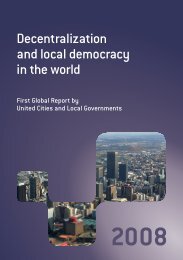Making Cities Resilient Report 2012
Making Cities Resilient Report 2012
Making Cities Resilient Report 2012
You also want an ePaper? Increase the reach of your titles
YUMPU automatically turns print PDFs into web optimized ePapers that Google loves.
CHAPTER 5 | LOOKING FORWARD: WHAT ARE SOME POSSIBLE APPROACHES TO MEASURING RESILIENCE IN CITIES<br />
Box 5.5 : Types of Financing for Disaster Risk Reduction Used<br />
by the Campaign <strong>Cities</strong><br />
Type of financing<br />
Direct municipal budget for DRR<br />
Mainstreamed municipal budget<br />
National budget for disaster risk reduction<br />
National funding available (subject to city bid)<br />
Budget for disaster relief/response/recovery<br />
Partnerships with international organisations<br />
(including NGOs)<br />
Partnerships with local NGOs<br />
Technical Assistance<br />
Private Sector<br />
City Examples<br />
Beirut, Cairns, Makassar, Colombo, Albay, San Francisco<br />
(Philippines), Makati<br />
Quito, Cape Town, Cairns, Makassar, Colombo, Barcelona<br />
Philippines<br />
Chile, South Africa, Sri Lanka<br />
Cape Town (from national-level), Makati, Thimpu<br />
San Francisco (Philippines), Makassar, Kisumu, Mumbai,<br />
Istanbul, Makati, Dubai, Batticaloa, Tyrol<br />
San Francisco (Philippines),Makassar, Cape Town, Makati,<br />
Overstrand<br />
Makati, Mumbai, Bangkok, Istanbul,<br />
Siquirres, Cape Town, San Francisco (Philippines), Makassar,<br />
Makati, Chacao, Tyrol<br />
Next steps<br />
This chapter has looked at possible ways to measure resilience and points to future steps for developing<br />
tools to aid cities and municipalities to do so. Ultimately, the context of each city and country is different,<br />
and therefore, how a city measures its own resilience must be locally driven. The participating partners<br />
and local governments in the <strong>Making</strong> <strong>Cities</strong> <strong>Resilient</strong> Campaign can work towards developing clear tools<br />
and methods to assist cities to measure the effectiveness of disaster risk reduction practices and link<br />
these to other on-going initiatives on resilient cities and urban performance indicators. The application<br />
of the Ten Essentials and the HFA Local Government Self-Assessment Tool is a starting point, and cities<br />
are actively working on many of these aspects. In addition to planning and measuring specific disaster<br />
risk reduction actions, it is also important to measure the accumulated resilience in cities, linked to basic<br />
services, which will give an overall picture of how well a city can withstand and bounce back from a hazard<br />
event.<br />
It is likely that the <strong>Making</strong> <strong>Cities</strong> <strong>Resilient</strong> Campaign will contribute, in the coming years, to improving the<br />
understanding of and local knowledge about disaster risk reduction, better urban planning principles for<br />
resilience building and city-level financing and investment for disaster risk reduction.<br />
<strong>Making</strong> <strong>Cities</strong> <strong>Resilient</strong> <strong>Report</strong> <strong>2012</strong> | 75

















